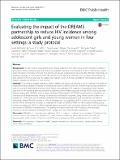Evaluating the Impact of the DREAMS Partnership to Reduce HIV Incidence among Adolescent Girls and Young Women in Four Settings: A Study Protocol
View/
Publication Date
2018-07-25Type
Article, Journalviews
downloads
Metadata
Show full item recordCitation
Birdthistle I, Schaffnit SB, Kwaro D, Shahmanesh M, Ziraba A, Kabiru CW, Phillips-Howard P, Chimbindi N, Ondeng'e K, Gourlay A, Cowan FM, Hargreaves JR, Hensen B, Chiyaka T, Glynn JR, Floyd S. Evaluating the impact of the DREAMS partnership to reduce HIV incidence among adolescent girls and young women in four settings: a study protocol. BMC Public Health. 2018 Jul 25;18(1):912. doi: 10.1186/s12889-018-5789-7. PMID: 30045711; PMCID: PMC6060450.
Abstract/
Background: HIV risk remains unacceptably high among adolescent girls and young women (AGYW) in southern and eastern Africa, reflecting structural and social inequities that drive new infections. In 2015, PEPFAR (the United States President's Emergency Plan for AIDS Relief) with private-sector partners launched the DREAMS Partnership, an ambitious package of interventions in 10 sub-Saharan African countries. DREAMS aims to reduce HIV incidence by 40% among AGYW over two years by addressing multiple causes of AGYW vulnerability. This protocol outlines an impact evaluation of DREAMS in four settings. Methods: To achieve an impact evaluation that is credible and timely, we describe a mix of methods that build on longitudinal data available in existing surveillance sites prior to DREAMS roll-out. In three long-running surveillance sites (in rural and urban Kenya and rural South Africa), the evaluation will measure: (1) population-level changes over time in HIV incidence and socio-economic, behavioural and health outcomes among AGYW and young men (before, during, after DREAMS); and (2) causal pathways linking uptake of DREAMS interventions to 'mediators' of change such as empowerment, through to behavioural and health outcomes, using nested cohort studies with samples of ~ 1000-1500 AGYW selected randomly from the general population and followed for two years. In Zimbabwe, where DREAMS includes an offer of pre-exposure HIV prophylaxis (PrEP), cohorts of young women who sell sex will be followed for two years to measure the impact of 'DREAMS+PrEP' on HIV incidence among young women at highest risk of HIV. In all four settings, process evaluation and qualitative studies will monitor the delivery and context of DREAMS implementation. The primary evaluation outcome is HIV incidence, and secondary outcomes include indicators of sexual behavior change, and social and biological protection. Discussion: DREAMS is, to date, the most ambitious effort to scale-up combinations or 'packages' of multi-sectoral interventions for HIV prevention. Evidence of its effectiveness in reducing HIV incidence among AGYW, and demonstrating which aspects of the lives of AGYW were changed, will offer valuable lessons for replication.
Subject/
Adolescent health; Complex intervention; Gender equity; HIV prevention; Impact evaluation; Kenya; South Africa; Zimbabwe
Further Details
© The Author(s). 2018 Open Access This article is distributed under the terms of the Creative Commons Attribution 4.0 International License (http://creativecommons.org/licenses/by/4.0/), which permits unrestricted use, distribution, and reproduction in any medium, provided you give appropriate credit to the original author(s) and the source, provide a link to the Creative Commons license, and indicate if changes were made. The Creative Commons Public Domain Dedication waiver (http://creativecommons.org/publicdomain/zero/1.0/) applies to the data made available in this article, unless otherwise stated.
Publisher
BMCCollections
- General - GEN [367]

